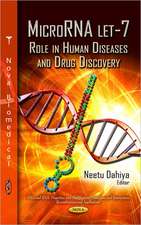Molecular Genetic Epidemiology: A Laboratory Perspective: Principles and Practice
Editat de Ian N.M. Dayen Limba Engleză Paperback – 23 oct 2001
| Toate formatele și edițiile | Preț | Express |
|---|---|---|
| Paperback (1) | 637.78 lei 6-8 săpt. | |
| Springer Berlin, Heidelberg – 23 oct 2001 | 637.78 lei 6-8 săpt. | |
| Hardback (1) | 643.34 lei 6-8 săpt. | |
| Springer Berlin, Heidelberg – 23 oct 2001 | 643.34 lei 6-8 săpt. |
Din seria Principles and Practice
- 15%
 Preț: 638.76 lei
Preț: 638.76 lei - 18%
 Preț: 1398.00 lei
Preț: 1398.00 lei - 18%
 Preț: 946.55 lei
Preț: 946.55 lei - 18%
 Preț: 1224.36 lei
Preț: 1224.36 lei - 18%
 Preț: 1229.40 lei
Preț: 1229.40 lei - 5%
 Preț: 362.88 lei
Preț: 362.88 lei - 18%
 Preț: 1209.52 lei
Preț: 1209.52 lei - 18%
 Preț: 953.03 lei
Preț: 953.03 lei - 15%
 Preț: 646.94 lei
Preț: 646.94 lei - 15%
 Preț: 644.95 lei
Preț: 644.95 lei - 5%
 Preț: 1104.68 lei
Preț: 1104.68 lei - 18%
 Preț: 1545.75 lei
Preț: 1545.75 lei - 15%
 Preț: 639.41 lei
Preț: 639.41 lei - 5%
 Preț: 710.06 lei
Preț: 710.06 lei - 18%
 Preț: 952.89 lei
Preț: 952.89 lei
Preț: 637.78 lei
Preț vechi: 750.33 lei
-15% Nou
Puncte Express: 957
Preț estimativ în valută:
122.09€ • 125.64$ • 102.92£
122.09€ • 125.64$ • 102.92£
Carte tipărită la comandă
Livrare economică 28 februarie-14 martie
Preluare comenzi: 021 569.72.76
Specificații
ISBN-13: 9783540413875
ISBN-10: 3540413871
Pagini: 228
Ilustrații: XII, 214 p.
Dimensiuni: 155 x 235 x 12 mm
Greutate: 0.35 kg
Ediția:2002
Editura: Springer Berlin, Heidelberg
Colecția Springer
Seria Principles and Practice
Locul publicării:Berlin, Heidelberg, Germany
ISBN-10: 3540413871
Pagini: 228
Ilustrații: XII, 214 p.
Dimensiuni: 155 x 235 x 12 mm
Greutate: 0.35 kg
Ediția:2002
Editura: Springer Berlin, Heidelberg
Colecția Springer
Seria Principles and Practice
Locul publicării:Berlin, Heidelberg, Germany
Public țintă
ResearchCuprins
1 Mapping Genes for Common Diseases: Statistical Planning, Power, Efficiency and Informatics.- 1.1 Introduction.- 1.2 Power and Sampling Considerations.- 1.3 Models of Locus Action.- 1.4 Maximum Likelihood Estimation.- 1.5 Allelic Association.- 1.6 The Malecot Model for Association.- 1.7 Candidate Genes for Allelic Association.- 1.8 Significance Levels.- 1.9 Meta-Analysis.- 1.10 Informatics.- 1.11 Summary.- References.- 2 Human DNA Sampling and Banking.- 2.1 Introduction.- 2.2 A Brief History of DNA Research.- 2.3 Goals and Needs of Human Population Genetics.- 2.4 Selection of the Source Tissue.- 2.5 A Fundamental Change in Sampling Methodology.- 2.6 DNA Isolation and Purification.- 2.7 Sample Storing.- 2.8 Sample Banking.- References.- 3 Microsatellite Genotyping.- 3.1 Introduction.- 3.2 Microsatellite Markers.- 3.3 The Genotyping Process - Experimental Considerations.- 3.4 Data Analysis.- 3.5 Data Management.- 3.6 Hardware.- 3.7 Future Developments.- 3.8 Applications.- References.- 4Minisatellite and Microsatellite DNA Fingerprinting.- 4.1 Introduction.- 4.2 Blood Grouping.- 4.3 DNA Fingerprinting — The Discovery.- 4.4 DNA Fingerprinting — The Applications.- 4.5 An Explosion of DNA Fingerprinting Sequences.- 4.6 Shortcomings of Multilocus Probes.- 4.7 Single Locus Probes — DNA Profiling.- 4.8 Europe and the USA Disagree.- 4.9 Lessons from the Castro Case.- 4.10 Impact of PCR.- 4.11 Digital DNA Typing.- 4.12 Short Tandem Repeat Profiling.- 4.13 The UK National DNA Database.- 4.14 STR Profiling Applications.- 4.15 The Future.- References.- 5 Multiplex Polymerase Chain Reaction and Immobilized Probes: Application to Cardiovascular Disease.- 5.1 Introduction.- 5.2 Multiplex Polymerase Chain Reaction (PCR) Methodology.- 5.3 Sequence-Specific Oligonucleotide Probe (SSOP) Methodology.- 5.4 Example: Candidate Markers of CVD Risk.- 5.5 Summary.- References.- 6 The Special Case of HLA Genes: Detection and Resolution of Multiple Polymorphic Sites in a Single Gene.- 6.1 Introduction.- 6.2 The HLA System.- 6.3 Requirement for HLA Genotyping: Historical Perspectives.- 6.4 PCR-based Approaches to HLA Genotyping.- 6.5 A PCR-SSOP-Based Strategy for HLA Class II Typing Using DNA Derived from Archival Tissue Banks.- 6.6 Concluding Remarks.- References.- 7 Microplate Array Diagonal Gel Electrophoresis (MADGE) Methodologies: The First Five Years.- 7.1 Introduction.- 7.2 Microplate Array Diagonal Gel Electrophoresis (MADGE).- 7.3 CpG-PCR.- 7.4 Temporal Thermal Ramp MADGE Electrophoresis (Melt-MADGE).- 7.5 Software Applications (Applies to All MADGE Not Just Melt-MADGE).- 7.6 Future Developments.- References.- 8 The Use of Sequence Analysis for Homozygote and Heterozygote Base Variation Discovery.- 8.1 Introduction.- 8.2 Sequence Analysis: a Polymorphism Discovery Method.- 8.3 Key Advancements in Sequencing Technologies: Chemistries, Hardware, and Software.- 8.4 Heterozygote and Homozygote Polymorphism Base Calling.- 8.5 Strategies for Sequencing-Based PolymorphismDetection.- 8.6 Summary and Outlook: To Sequence or Not To Sequence — This Is Not in Question.- References.
Caracteristici
Principles and practice of molecular techniques used in Epidemiology Special emphasis on high-throughput technologies Includes supplementary material: sn.pub/extras















